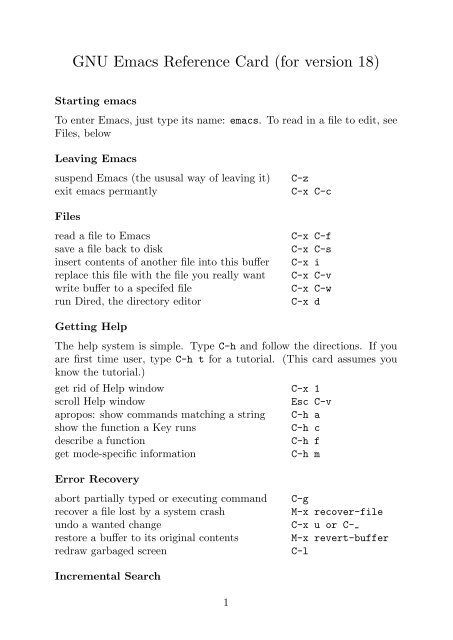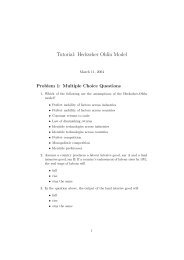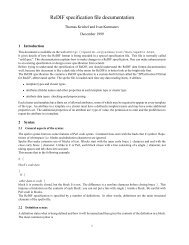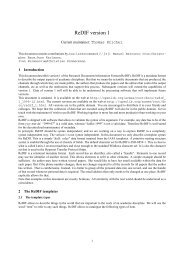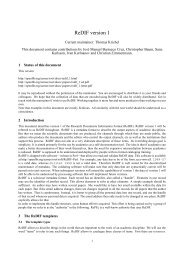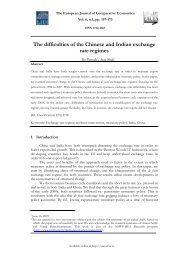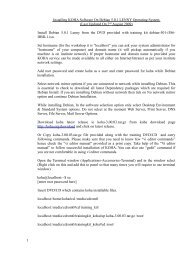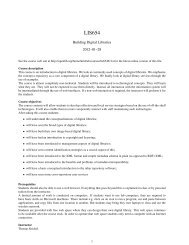GNU Emacs Reference Card (for version 18)
GNU Emacs Reference Card (for version 18)
GNU Emacs Reference Card (for version 18)
Create successful ePaper yourself
Turn your PDF publications into a flip-book with our unique Google optimized e-Paper software.
<strong>GNU</strong> <strong>Emacs</strong> <strong>Reference</strong> <strong>Card</strong> (<strong>for</strong> <strong>version</strong> <strong>18</strong>)Starting emacsTo enter <strong>Emacs</strong>, just type its name: emacs. To read in a file to edit, seeFiles, belowLeaving <strong>Emacs</strong>suspend <strong>Emacs</strong> (the ususal way of leaving it)exit emacs permantlyFilesread a file to <strong>Emacs</strong>save a file back to diskinsert contents of another file into this bufferreplace this file with the file you really wantwrite buffer to a specifed filerun Dired, the directory editorC-zC-x C-cC-x C-fC-x C-sC-x iC-x C-vC-x C-wC-x dGetting HelpThe help system is simple. Type C-h and follow the directions. If youare first time user, type C-h t <strong>for</strong> a tutorial. (This card assumes youknow the tutorial.)get rid of Help window C-x 1scroll Help windowEsc C-vapropos: show commands matching a string C-h ashow the function a Key runsC-h cdescribe a functionC-h fget mode-specific in<strong>for</strong>mationC-h mError Recoveryabort partially typed or executing command C-grecover a file lost by a system crashM-x recover-fileundo a wanted change C-x u or C-restore a buffer to its original contents M-x revert-bufferredraw garbaged screenC-lIncremental Search1
search <strong>for</strong>wardsearch backwardregular expression searchC-sC-rC-M-sUse C-s or C-r again to repeat the search in either directionexit increamental searchundo effect of last characterabort current searchESCDELC-gIf <strong>Emacs</strong> is still searching, C-g will cancel the parts of the search notdone, otherwise it aborts the entire search.MotionCursor motion:entity to move over backward <strong>for</strong>wardcharacter C-b C-fword M-b M-fline C-p C-ngo to beginning (or end) C-a C-esentence M-a M-eparagraph M-[ M-]page C-x [ C-x ]sexp C-M-b C-M-ffunction C-M-a C-M-ego to buffer beginning (or end) M-< M->Screen Motion:scroll to next screenC-vscroll to previous screenM-vscroll left C-x Killing and Deletingentity to kill backward <strong>for</strong>wardcharacter(delete, not kill) DEL C-dword M-DEL M-dline (to end of) M-O C-k C-ksentence C-x DEL M-ksexp M-- C-M-k C-M-kkill regionC-w2
kill to next occurence of “char”yank back last thing killedreplace last yank with previous killM-z charC-yM-yMarkingset mark hereexchange point and markset mark “arg” words awaymark paragraphmark sexpmark functionmark entire bufferC-@ or C-SPCC-x C-xM-@M-hC-M-@C-M-hC-x hQuery Replaceinteractively replace a text stringusing regular expressionsValid responses in query-replace mode arereplace this one, go on to nextSPCreplace this one, don’t move ,skip to next without replacingDELreplace all remaining matches !back up to the previous match^exit query-replaceESCenter recursive edit(C-M-c to exit)C-rMultiple WindowsM-%M-x query-replace-regexpdelete all other windows C-x 1delete this window C-x 0split window in 2 vertically C-x 2split window in 2 horizontally C-x 5scroll other windowC-M-vswitch cursor to another windowC-x oshrink window shorterM-x shrink-windowshrink window tallerC-x ^shrink window narrower C-x {shrink window wider C-x }select a buffer in other windowC-x 4 bfind file in other windowC-x 4 f3
compose mail in other windowC-x 4 mrun Dired in other windowC-x 4 dfind tag in other window C-x 4 .Formattingindent current line(mode dependent)TABindent region(mode dependent)C-M-\indent sexp(mode dependent)C-M-qindent region rigidly ”arg” columnsC-x TABinsert newline after pointC-omove rest of the line vertically downC-M-odelete blank lines around pointC-x C-odelete all white space arround pointM-\put exactly one space at pointM-SPCfill paragraphM-qfill regionM-gset fill columnC-x fset prefix each line starts with C-x .Case Changeuppercase wordlowercase wordcapitalize worduppercase regionlowercase regioncapitalize regionM-uM-lM-cC-x C-uC-x C-lM-x capitalize-regionThe MinibufferThe following keys are defined in the minibuffercomplete as much as possibleTABcomplet up to one wordSPCcomplete and executeRETshow possible completions ?abort commandC-gType C-x ESC to edit and repeat the last command that used the minibuffer. The following keys are then defined.previous minibuffer commandnext minibuffer command4M-pM-n
Buffersselect another bufferlist all bufferskill a bufferC-x bC-x C-bC-x kTransposingtranspose characterstranspose wordstranspose linestranspose sexpsC-tM-tC-x C-tC-M-tSpelling Checkcheck spelling of current wordcheck speelin of all words in regioncheck spelling <strong>for</strong> entire bufferM-$M-x spell-regionM-x spell-bufferTagsfind tagfind next occurence of tagspecify a new tags fileregexp search on all files in tags tablequery replace all the filescontinue last tags search or query-replaceM-.C-u M-.M-x visit-tags-tableM-x tags-searchM-x tags-query-replaceM-,Shellsexecute a shell commandrun a shell command on the regionfilter region through a shell commandstart a shell in window *shell*M-!M-|C-u M-|M-x shellRmailscroll <strong>for</strong>wardSPCscroll reverseDELbegenning of message . (dot)next non-deleted messagenprevious non-deleted messagepnext messageM-n5
previous messagedelete messagedelete message and back upundelete messagereply to message<strong>for</strong>ward message to someonesend mailget newly arrived mailquit Rmailoutput message to another Rmail fileoutput message in Unix-mail styleshow summary of headersM-pdC-durfmgqoC-ohRegular ExpressionsThe following have special meaning inside a regular expression.any single character. (dot)zero or more repeats *one or more repeats +zero or one repeat ?any character in set [...]any character not in set[^...]beginning of line^end of line $quote a special character ”c” \calternative ”or” \|grouping \(. . . )\)nth group \nbeginning of buffer \‘end of buffer \’word break \bnot beginning or end of word \Bbeginning of word \any word-syntax character \wany non word-syntax character \Wcharacter with syntax ”c”\sccharacter with syntax not ”c”\ScRegisters6
copy region to registerC-x xinsert register contentsC-x gsave point in register C-x /move point to saved locationC-x jInfoenter the Info documentation readerMoving within a node:scroll <strong>for</strong>wardscroll reversebeginning of nodeMoving between nodes:next nodeprevious nodemove upselect menu item by nameselect ”n”th menu item by number (1-5)follow cross reference (return with l)return to last node you sawreturn to directory nodego to any node by nameC-h iSPCDEL.(dot)npumnfldgOther:run Info tutorialhlist Info commands ?quit Infoqsearch nodes <strong>for</strong> regexpsKeyboard Macrosstart defining a keyboard macro C-x (end keyboard macro definition C-x )execute last-defined keyboard macroC-x eappend to last keyboard macroM-x name-last-kbd-macroinsert lisp definition in bufferM-x insert-kbd-macroCommands Dealing with <strong>Emacs</strong> Lispeval sexp be<strong>for</strong>e pointC-x C-e7
eval current defuneval regioneval entire bufferread and eval minibufferre-execute last minibuffer commandread and eval <strong>Emacs</strong> Lisp fileload from standard system directoryC-M-xM-x eval-regionM-x eval-current-bufferM-ESCC-x ESCM-x load-fileM-x load-librarySimple CustomizationHere are some examples of binding global keys in <strong>Emacs</strong> Lisp. Note thatyou cannot say “\M-#”; you must say “\e#”.(global-set-key "\C-cg" ’goto-line)(global-set-key "\e\C-r" ’isearch-backward-regexp)An example of setting a variable in <strong>Emacs</strong> Lisp:(setq backup-by-copying-when-linked t)Writing Commands(defun ()""(interactive ""))An example:(defun this-line-to-top-of-screen (line)"Reposition line point is on to the top ofthe screen. With ARG, put point on line ARG.Negetive counts from bottom."(interactive "P")(recenter (if (null line)0(prefix-numeric-value line))))The argument to interactive is a string specifying how to get the argumentswhen the function is called interactively. Type C-h f interactive<strong>for</strong> more in<strong>for</strong>mation.8


